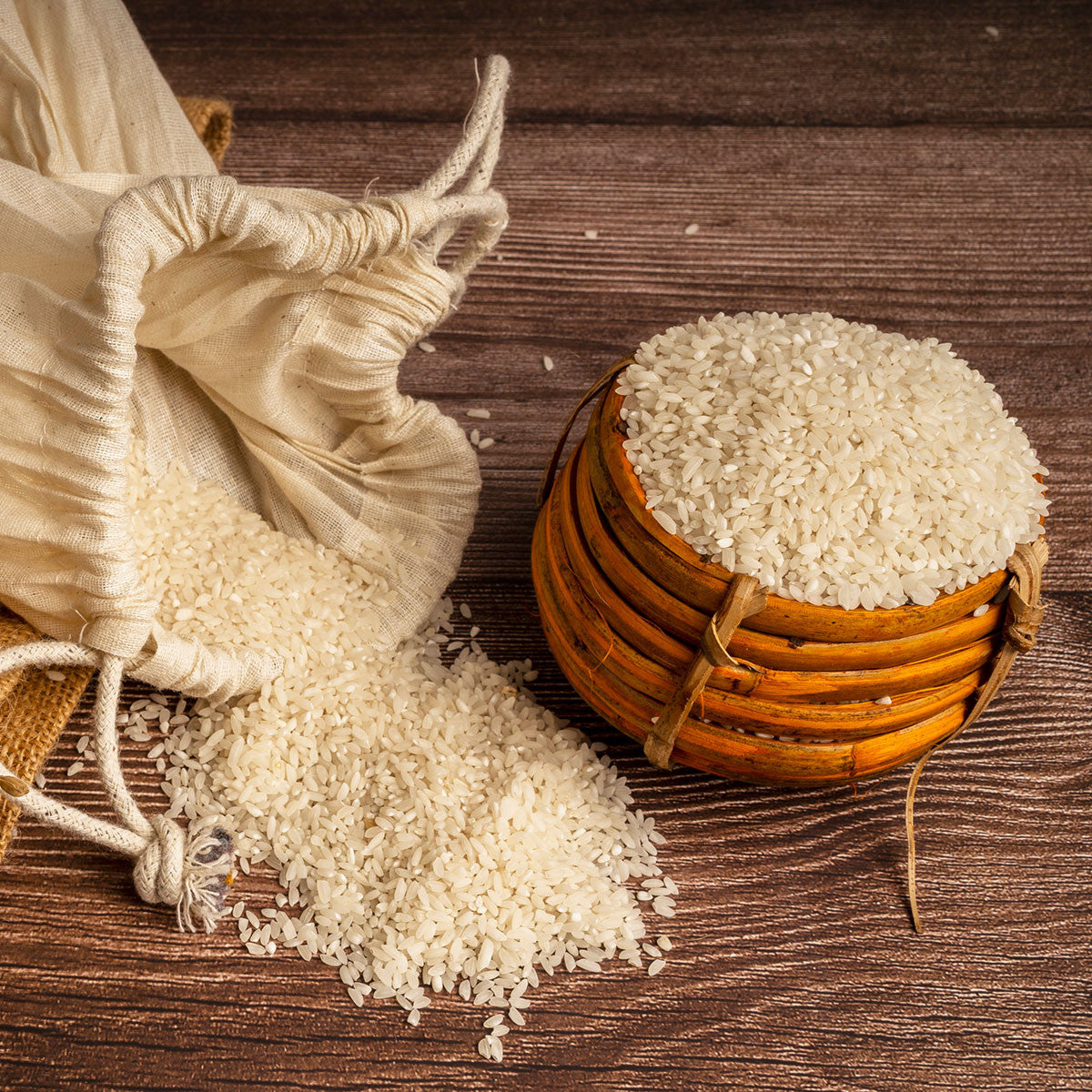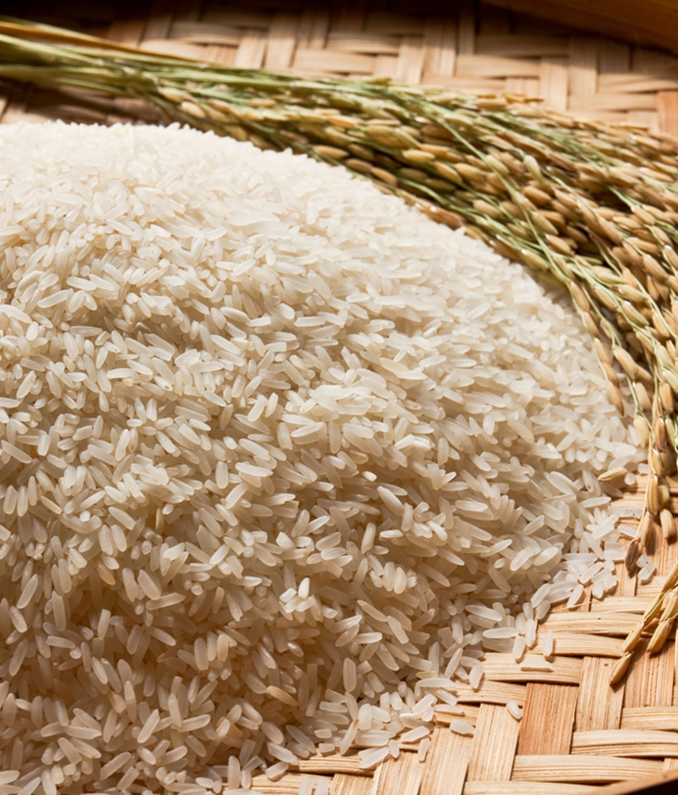#SWAHIndra
तुलापांजी - स्थिर ऊर्जा आणि पचन आरोग्य
तुलापांजी - स्थिर ऊर्जा आणि पचन आरोग्य
पिकअप उपलब्धता लोड करू शकलो नाही
कमी ग्लायसेमिक इंडेक्स असलेला सुगंधी, प्रथिनेयुक्त भात, रक्तातील साखरेची पातळी स्थिर ठेवण्यासाठी, चांगले पचन आणि एकूण आरोग्यासाठी आदर्श.



What Makes Tulaipanji Rice Unique?
Photo Sensitive Growth
Tulaipanji rice is grown during the kharif season, benefiting from the unique light conditions that help develop its distinct aroma and texture.
Straw Coloured Grains
The rice’s grains are a beautiful straw colour with long awns, making it visually distinct and appealing in every dish.
Perfect Grain Size
With medium-long slender grains, Tulaipanji rice has an elongation ratio of 1.6, giving it a fluffy and light texture when cooked.
Pleasing Cooking Texture
Once cooked, Tulaipanji rice transforms into a delicious, bright, and perfectly textured grain that adds charm to any meal.
Nutritious Protein Content
Packed with 7.3% protein, Tulaipanji rice supports a balanced diet, making it a nourishing option for every family.
Ideal for Special Dishes
Tulaipanji’s unique aroma and texture make it the ideal choice for creating flavourful biryanis, polao, and other traditional dishes that elevate any occasion.
Introduction
Tulaipanji rice, a treasured grain from West Bengal, stands out for its deep aroma and rich culinary heritage. Unlike many fragrant rice varieties, its scent remains intact even after parboiling, making it a sought-after choice for biryanis, polao, and traditional sweets. Grown primarily in the Dinajpur region, this rice thrives naturally with strong resistance to pests, ensuring both quality and sustainability. Its soft yet non-sticky texture, along with a well-balanced nutritional profile, makes it a staple for those who appreciate both flavour and nourishment.
Nutrional values you get from our Tulaipanji Rice
A Healthy Source of Essential Nutrients
Protein
(7.30% to 8.30%)
Fibre
(1.29)
Fat
(2.25%)
Iron
(16.00 μg/g)
Zinc
(91.64 μg/g)
Phosphorus
(212.25 μg/g)
Copper
(45.50 μg/g)
Carbohydrate
(78-80%)
Aromatic
(Strong)
Starch
(68.99%)
Resistant starch
(0.87%)
Glycaemic index
(67.38%)
Anti-oxidant activity (IC50)
(873.67 µg/ml)
Total phenolic content
(31.22 µg/g, FW)
Flavonoids
(54.22 µg/g, FW)
How Tulaipanji Rice Helps You and the Planet



Supports Biodiversity
Tulaipanji rice powerfully supports the maintenance of local agricultural variety through the encouragement of ecological balance and the large lessening of genetic loss.
Reduces Environmental Impact
Cultivated with minimal chemical intervention, it supports sustainable farming practises and reduces the need for pesticides.
Helps Farmers Thrive
The special quality and flavour of Tulaipanji generate meaningful market demand providing greater income opportunities for farmers in West Bengal.
Preserves Cultural Heritage
Tulaipanji rice strengthens the community’s livelihood and sustains the region’s agricultural heritage by strongly supporting customary cultivation methods.
FAQs
Find answers to all your key questions about Tulaipanji rice
What is Tulaipanji rice?
Tulaipanji is a traditional, aromatic rice variety native to the Dinajpur region of West Bengal, India. It is known for its strong and stable aroma, non-sticky grains, and good cooking quality.
What makes Tulaipanji unique?
Tulaipanji rice is unique because of its pleasant, strong aroma, which remains even after parboiling. It has medium-long slender grains, low amylose content, and is known for its excellent cooking texture. Additionally, its aroma can last up to a year in both raw and parboiled forms.
How is Tulaipanji rice nutritionally superior?
Tulaipanji rice stands out for its rich nutritional profile, offering a balanced mix of protein (7.30-8.30%), fibre, and essential minerals like iron, zinc, and phosphorus. Its high antioxidant content, flavonoids, and phenolic compounds contribute to better immunity and overall health. With a moderate glycaemic index (67.38%) and resistant starch, it supports sustained energy release and better digestion. The strong natural aroma adds to its appeal, making it both a nutritious and flavourful choice.
What are the health benefits of Tulaipanji rice?
Tulaipanji rice is rich in protein (7.3%) and contains moderate amounts of essential nutrients like amylose and proteins. It is low in fat and is often preferred for its mild flavour and easy digestion.
What is the shelf life of Tulaipanji rice?
When stored in a cool, dry place in an airtight container, Tulaipanji rice can last up to 6–12 months without losing its aroma and quality.
How do you cook Tulaipanji rice for the best results?
To cook Tulaipanji rice for the best results, start by rinsing it thoroughly and soaking for 15 minutes to ensure even cooking. Use a rice-to-water ratio of 1:1.5 and cook using the absorption method. For best results, cook on medium heat in a pressure cooker for 2-3 whistles or simmer in a pot until the water is absorbed. Typically, it takes around 25 minutes to cook. After cooking, allow the rice to rest for 5-10 minutes to ensure a fluffy texture and enhance the aroma.
How does Tulaipanji rice compare to Basmati rice?
Tulaipanji rice differs from Basmati rice in its grain size, aroma, and texture. While Basmati has long, slender grains and a distinct nutty fragrance, Tulaipanji has shorter grains with a pleasant mango-blossom aroma. Tulaipanji rice is non-sticky and slightly firmer when cooked, whereas Basmati is known for its fluffy, separate grains.
How should Tulaipanji rice be stored?
Store Tulaipanji rice in a cool, dry place in an airtight container to protect it from moisture, dust, and insects.
How can Tulaipanji rice be preserved?
Preservation of Tulaipanji rice can be done through both in-situ (on-farm) and ex-situ (off-farm) conservation methods. Farmers are encouraged to save their own seeds, and various conservation initiatives are being introduced to maintain its genetic purity.
What are the challenges in cultivating Tulaipanji rice?
Tulaipanji faces challenges such as low productivity compared to high-yielding varieties, susceptibility to lodging (falling over), genetic erosion due to cross-pollination with non-aromatic varieties, and the declining aroma due to modern farming practises.
Where is Tulaipanji rice grown?
Tulaipanji is traditionally grown in small pockets in the North and South Dinajpur districts of West Bengal, India. It thrives in the old alluvial regions of these areas.
Why is Tulaipanji rice preferred for specific dishes?
Tulaipanji rice’s long, slender grains and non-sticky texture make it perfect for special dishes like biryani, polao, and fried rice, enhancing their flavour with its distinct fragrance













